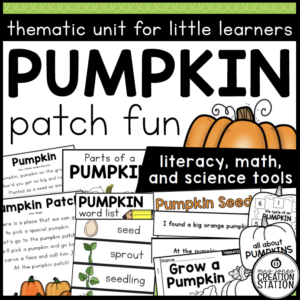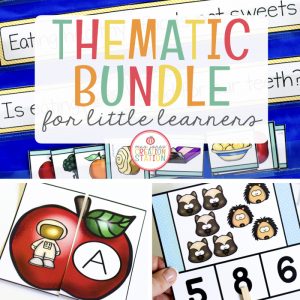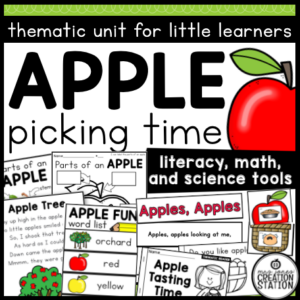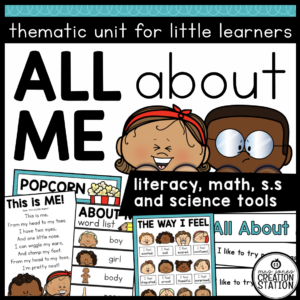Menu
This resource includes thematic lessons, activities, poems, songs, and centers for your little learners. Adapt these resources to meet the specific needs of your learners in whole group, small group, and independent instruction.
Buy the BUNDLE and SAVE! You can purchase this resource in the Thematic Activities for Little Learners Bundle!
Week 29 Plans
This is a template for lesson plans during a plants thematic unit. For best results, pick and choose what ideas and resources work for your learners. Furthermore, you may adapt the resources to best meet your students’ needs.
Plants – Whole Group
These resources can be used during whole group instruction for a plants theme. During whole group instruction, you may use the poem, word cards, tracing page, and table sign-in sheets.
Plant Interactive Poem
During this thematic unit, use this poem during a thematic lesson, whole group or a literacy center. For instance, have learners learn different types of fruits and vegetables.
Plant Sensory Charts
During this activity, students may explore plants in a garden with the five senses. For example, omplete the charts together and have learners draw and write about their experience in a garden using their senses on the interactive page.
Plants Predictable Chart Class Book
During this thematic unit, use this resource to create a class book. For example, create a predictable chart during the week. Then, have learners write and illustrate their page for the class book.
Plants Thematic Plans
During this thematic unit, use these plans as a guide for engaging plant read alouds and activities in the classroom.
What a Plant Needs
During this thematic lesson, read Good Work: Plant Life. Then use the cards provided to create the first anchor chart of the week. Finally, learners may use the chart to complete the Plant book.
Parts of a Plant
During this thematic lesson, read Exploring Seeds. Then, use the cards provided to create the next anchor chart of the week. Finally, learners may use the chart to complete the Plant book.
What We Can Eat
During this thematic lesson, read Plants Feed Me, Then, use the cards provided to create the next anchor chart of the week. Finally, learners may use the chart to complete the Plant book.
Growing a Plant
During this thematic lesson, read The Amazing Life Cycle of Plants. Then, use the cards provided to create the next anchor chart of the week. Finally, learners may use the chart to complete the Plant book.
Plant a Seed
During this thematic lesson, read One Bean. Then, work together to complete the steps to planting a seed. Finally, have learners plant a seed or bean in a pot.
Literacy Center | Alphabet Pocket Chart
During this learning center, have learners sort the capital, lowercase and picture card for each letter of the alphabet on a pocket chart. Then learners may record the answers on the page provided.
Literacy Center | CVC Words
During this learning center, have learners find the letters needed to create each word. Then learners may record the answers on the page provided.
Literacy Center | Alphabet Mats
During this learning center, have learners trace and write each letter of the alphabet for handwriting practice.
Math Center | Addition
During this learning center, have learners match each plant to the pot that equals its sum. Then learners may record the answers on the page provided.
Math Center | Matching Patterns
During this learning center, have learners match the pattern puzzles and create patterns that match the puzzles. Then learners may record the answers on the page provided.
Math Center | Teen Numbers
During this learning center, have learners put a clip on the number that represents the set in each of the pictures. Then learners may record the answers on the page provided.
NGSSK-ESS2-2
Construct an argument supported by evidence for how plants and animals (including humans) can change the environment to meet their needs. Examples of plants and animals changing their environment could include a squirrel digs in the ground to hide its food and tree roots can break concrete.
NGSSK-ESS3-1
Use a model to represent the relationship between the needs of different plants or animals (including humans) and the places they live. Examples of relationships could include that deer eat buds and leaves, therefore, they usually live in forested areas; and, grasses need sunlight so they often grow in meadows. Plants, animals, and their surroundings make up a system.
CCSSMP8
Look for and express regularity in repeated reasoning. Mathematically proficient students notice if calculations are repeated, and look both for general methods and for shortcuts. Upper elementary students might notice when dividing 25 by 11 that they are repeating the same calculations over and over again, and conclude they have a repeating decimal.
By paying attention to the calculation of slope as they repeatedly check whether points are on the line through (1, 2) with slope 3, middle school students might abstract the equation (𝑦 – 2)/(𝑥 – 1) = 3. Noticing the regularity in the way terms cancel when expanding (𝑥 – 1)(𝑥 + 1), (𝑥 – 1)(𝑥² + 𝑥 + 1), and (𝑥 – 1)(𝑥³ + 𝑥² + 𝑥 + 1) might lead them to the general formula for the sum of a geometric series. As they work to solve a problem, mathematically proficient students maintain oversight of the process, while attending to the details. They continually evaluate the reasonableness of their intermediate results.
CCSSL.K.1a
Print many upper- and lowercase letters.
CCSSRF.K.4
Read emergent-reader texts with purpose and understanding.
CCSSRF.K.3
Know and apply grade-level phonics and word analysis skills in decoding words.
CCSSRF.K.1d
Recognize and name all upper- and lowercase letters of the alphabet.
CCSSK.OA.A.1
Represent addition and subtraction with objects, fingers, mental images, drawings, sounds (e.g., claps), acting out situations, verbal explanations, expressions, or equations.
CCSSK.CC.B.5
Count to answer “how many?” questions about as many as 20 things arranged in a line, a rectangular array, or a circle, or as many as 10 things in a scattered configuration; given a number from 1-20, count out that many objects.
CCSSK.CC.B.4b
Understand that the last number name said tells the number of objects counted. The number of objects is the same regardless of their arrangement or the order in which they were counted.
CCSSK.CC.B.4
Understand the relationship between numbers and quantities; connect counting to cardinality.
TEKSLA.K.2.B.ii
Developing and sustaining foundational language skills: listening, speaking, reading, writing, and thinking–beginning reading and writing. The student develops word structure knowledge through phonological awareness, print concepts, phonics, and morphology to communicate, decode, and spell. The student is expected to: demonstrate and apply phonetic knowledge by: using letter-sound relationships to decode, including VC, CVC, CCVC, and CVCC words;
TEKSLA.K.2.A.viii
Developing and sustaining foundational language skills: listening, speaking, reading, writing, and thinking–beginning reading and writing. The student develops word structure knowledge through phonological awareness, print concepts, phonics, and morphology to communicate, decode, and spell. The student is expected to: demonstrate phonological awareness by: blending spoken phonemes to form one-syllable words;
TEKSLA.K.2.B.i
Developing and sustaining foundational language skills: listening, speaking, reading, writing, and thinking–beginning reading and writing. The student develops word structure knowledge through phonological awareness, print concepts, phonics, and morphology to communicate, decode, and spell. The student is expected to: demonstrate and apply phonetic knowledge by: identifying and matching the common sounds that letters represent;
TEKSLA.K.2.D.v
Developing and sustaining foundational language skills: listening, speaking, reading, writing, and thinking–beginning reading and writing. The student develops word structure knowledge through phonological awareness, print concepts, phonics, and morphology to communicate, decode, and spell. The student is expected to: demonstrate print awareness by: identifying all uppercase and lowercase letters; and
TEKSLA.K.2.E
Developing and sustaining foundational language skills: listening, speaking, reading, writing, and thinking–beginning reading and writing. The student develops word structure knowledge through phonological awareness, print concepts, phonics, and morphology to communicate, decode, and spell. The student is expected to: develop handwriting by accurately forming all uppercase and lowercase letters using appropriate directionality.
TEKSMA.K.3.A
Number and operations. The student applies mathematical process standards to develop an understanding of addition and subtraction situations in order to solve problems. The student is expected to: model the action of joining to represent addition and the action of separating to represent subtraction;
TEKSMA.K.2.C
Number and operations. The student applies mathematical process standards to understand how to represent and compare whole numbers, the relative position and magnitude of whole numbers, and relationships within the numeration system. The student is expected to: count a set of objects up to at least 20 and demonstrate that the last number said tells the number of objects in the set regardless of their arrangement or order;
TEKSMA.K.2.A
Number and operations. The student applies mathematical process standards to understand how to represent and compare whole numbers, the relative position and magnitude of whole numbers, and relationships within the numeration system. The student is expected to: count forward and backward to at least 20 with and without objects;
TEKSMA.K.1.F
Mathematical process standards. The student uses mathematical processes to acquire and demonstrate mathematical understanding. The student is expected to: analyze mathematical relationships to connect and communicate mathematical ideas; and
TEKSSCI.K.9.B
Organisms and environments. The student knows that plants and animals have basic needs and depend on the living and nonliving things around them for survival. The student is expected to: examine evidence that living organisms have basic needs such as food, water, and shelter for animals and air, water, nutrients, sunlight, and space for plants.
TEKSSCI.K.10.C
Organisms and environments. The student knows that organisms resemble their parents and have structures and processes that help them survive within their environments. The student is expected to: identify ways that young plants resemble the parent plant; and
TEKSSCI.K.10.A
Organisms and environments. The student knows that organisms resemble their parents and have structures and processes that help them survive within their environments. The student is expected to: sort plants and animals into groups based on physical characteristics such as color, size, body covering, or leaf shape;
TEKSSCI.K.10.D
Organisms and environments. The student knows that organisms resemble their parents and have structures and processes that help them survive within their environments. The student is expected to: observe changes that are part of a simple life cycle of a plant: seed, seedling, plant, flower, and fruit.
TEKSSCI.K.10.B
Organisms and environments. The student knows that organisms resemble their parents and have structures and processes that help them survive within their environments. The student is expected to: identify basic parts of plants and animals;
TEKSSCI.K.9.A
Organisms and environments. The student knows that plants and animals have basic needs and depend on the living and nonliving things around them for survival. The student is expected to: differentiate between living and nonliving things based upon whether they have basic needs and produce offspring; and
How can I see what is new in the MJCS store?
Be the first to know about new discounts, freebies, and new products. You can also subscribe to our newsletter to receive access to resources only available to MJCS subscribers, as well as, special offers and ideas!
How can I get credit for my TpT purchases?
Go to your account button at the top of the page. Under the “Buy” section, click “My Purchases “. Beside each purchase you’ll see a Provide Feedback button. Simply click the button and you will be taken to a page where you can give a quick rating and leave a comment for the product. Each time you give feedback, TpT gives you feedback credits that you use to lower the cost of your future purchases. Please leave detailed feedback for each resource, so we are able to create better resources for teachers and students.
How can I find a certain activity in a large PDF file?
If the resource you purchase has a variety of activities compiled into one PDF find the table of contents and click on the activity title. This should take you to that specific activity in the resource.
What can I do if I have a question about a resource?
If you have any questions regarded a resource before purchasing please email me at mrsjonescreationstation[at]gmail.com. Once you have purchased the resource you may use the “Product Q and A” tab on the product page to ask a question, as well.
How do I know if a resource has been updated?
Go to your account button at the top of the page. Under the “Buy” section, click “My Purchases “. Choose to “sort by: recently updated” to see what resources have been updated since you downloaded them last. You can download any updates from there. If a file has been updated, you will see a notification under the resource that says “Newly Updated – Download for Free!”
This item is a paid product created by Mrs. Jones’ Creation Station, Inc. Copying any part of this product, redistributing, selling or placing it on the internet in any form is strictly forbidden and is a violation of the Digital Millennium Copyright Act (DMCA). Thank you for respecting our work!
YES, YOU CAN…
NO, YOU CAN’T…
Click here for a detailed post with step-by-step directions.
You will need to download fonts specified in the resource and install it on your computer before downloading the editable file.
Install the most recent version of Adobe Reader onto your computer. If you have any problems editing, viewing or printing a file make sure your Adobe Reader is updated.
Now you can download the file to your computer. Once the file has downloaded open in Adobe Reader. You should be able to view the editable fields and the text should match the product description. If you have any problems editing the file, make sure you have followed the directions above and then contact me at mrsjonescreationstation[at]gmail.com




